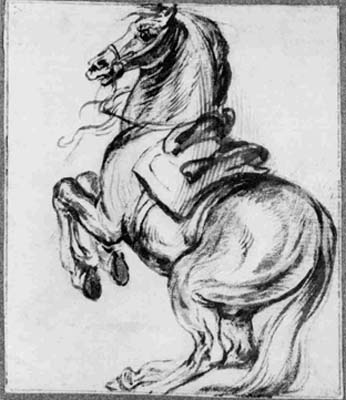
Bulletin 9-10 (V:1-2), 1967
Home
Français
Introduction
History
Annual Index
Author &
Subject
Credits
Contact

A
Drawing by Jacques Callot
This digital collection
was produced under contract to Canada's Digital Collections program,
Industry Canada.
by Mary C. Taylor, Assistant Curator
Prints and Drawings, National Gallery of Canada
Résumé en français
Page 1 | 2
The Department of
Prints and Drawings has recently purchased a drawing Étude
de cheval se cabrant (Study of a Rearing Horse), masterpiece of
Baroque draughtsmanship by the French seventeenth-century
artist, Jacques Callot (1592-1635}. It can be identified as
one of a series of horse drawings which Callot did in Florence
during the years 1615 to 1617. (1)
Callot has only recently emerged from the shadows of semi-legendary
detail which surrounded his personality ever since his biographer, Félibien,
remarked that he ran away from home with gypsies at the age of 12 to
learn the art of engraving in Rome. The clarification of certain
facts about Callot in a less picturesque but more truthful direction
is largely due to Daniel Ternois in his two recent monographs on the
artist. (2) Callot was born at Nancy, studied and worked in Italy and,
after the death in 1621 of his patron, Cosimo II de' Medici, returned
to spend the last 14 years of his life in Lorraine.
In his Catalogue complet Ternois publishes a series of
drawings of horses done in the same medium and style as the
National Gallery's recent acquisition. (3) The drawings are
identified as copies which Callot made after a series of 28 horses
engraved by Antonio Tempesta in 1590. (4) Callot had worked with
Tempesta briefly during a short stay in Rome before 1612, but the
copies were made while he was at the Florentine court. (5) Since the
publication of the initial 12 sheets others have come to light, (6) and
the Ottawa drawing is another addition to the group.
Our drawing differs from others in the series in that here Callot
makes fuller use of dry brush strokes to model the forms while
retaining the calligraphic line evident in all the drawings. The
rather curious series of curved parallel lines over the horse's mane
and back are lines drawn on the verso which show through and which
coincidentally accentuate the general movement. This emphasis on
solid forms and dynamic movement places the drawing squarely in the
mainstream of the period. It is as if Tempesta's original horses had
matured with the times and had become, under the hand of Callot, as
fully formed and splendidly ebullient as the early seventeenth
century itself.
Known chiefly, until recently, for his grotesque figures (often
drawn in crabbed, irregular pen line), or for his small and
painfully trenchant sketches of the horrors of the Thirty Year's
War, Callot shows himself here in his affluent and optimistic youth.
It is difficult to believe that fewer than 20 years intervene between
this rearing charger and the starved nags of later drawings.
Next Page | Notes
1 | 2
Annual
Index | Author
& Subject | Credits | Contact
"Digital
Collections Program, Copyright
© National Gallery of
Canada 2001"